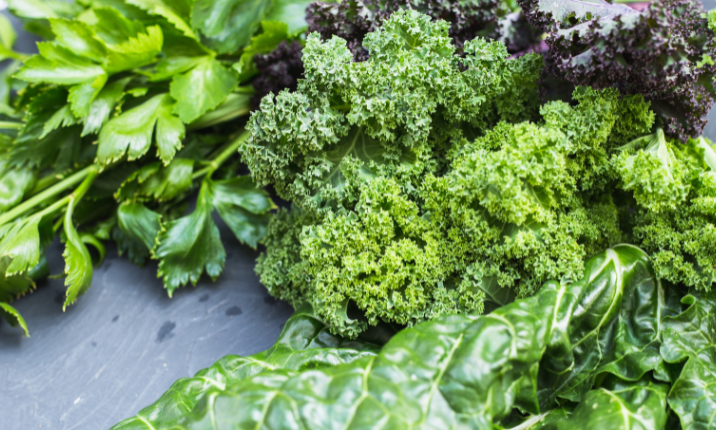We’ve all been told to eat our veggies from a young age. That’s because vegetables are nutrient dense and can help protect your health and reduce your risk of developing chronic health conditions. As a person living with diabetes, there are seven stellar picks that offer bonus benefits. Plan to fill half of every mealtime plate or bowl with non-starchy veggies by regularly enjoying these winners.
Spinach
Leafy greens, including spinach, kale, and collard greens, are low in carbs and calories but high in nutrition. They’re packed with vitamins A, C, and K, folic acid, calcium, iron, and powerful antioxidants which fight oxidative stress, help reduce damage to cells, and may help reduce the risk of developing heart disease. Research suggests leafy greens could reduce risk of developing chronic conditions like diabetes. Plus, they provide lutein and zeaxanthin, plant compounds that are beneficial for maintaining eye health. Spinach is the most widely available and enjoyed of all the leafy bunches.
Cooking tip: In recipes, add a squirt of lemon juice to spinach for taste balance. By combining the vitamin C from citrus fruits like lemons or oranges with dark leafy greens, the iron in the spinach is better absorbed.
Try this recipe: Garlic Sauteed Spinach and Kale
Broccoli
Broccoli contains soluble fiber, which can help maintain good gut health and manage blood glucose (blood sugar) levels. When not overcooked, broccoli is an excellent source of vitamin C and K. Cruciferous vegetables (veggies in the cabbage family like broccoli, kale, and brussels sprouts) contain sulforaphane, a bioactive compound which may help with blood glucose management.
Cooking tip: Don’t forget the stems! Try thinly slicing into coins and stir-frying them.
Try this recipe: Crispy Baked Broccoli
Bell Peppers
With their vivid colors, bell peppers offer a significant amount of vitamin C and beta-carotene, offering antioxidant benefits. Red bell peppers are slightly sweeter and richer in these health-protective nutrients than green peppers (their less ripe counterparts). All bell peppers are considered non-starchy vegetables, making them diabetes-friendly foods.
Cooking tip: Blend roasted peppers with hummus to create colorful dips.
Try this recipe: Simple Roasted Peppers
Tomatoes
Botanically, tomatoes are fruits. But since they’re nutritionally more similar to vegetables and typically used in savory dishes, consider tomatoes as veggies. Along with plenty of vitamin C, they’re rich in lycopene, a carotenoid pigment that may play a role in reducing the risk of developing diabetes, obesity, and heart disease. Enjoy all forms of tomatoes cooked or canned with low sodium or no added salt. For best taste and texture, don’t refrigerate whole raw tomatoes.
Cooking tip: Sauté (or “blister”) grape tomatoes in olive oil for a quick breakfast side.
Try this recipe: Italian-Style Blistered Tomatoes
Cauliflower
Nutritionally, cauliflower provides nutrients like folate and vitamins C and K. Like broccoli, it contains sulforaphane, but it stands out on the diabetes plate thanks to its versatility. Enjoy as a carb-friendly swap in place of rice, serve roasted thick slabs as “steak,” or slow-cook the head of cauliflower as a wow-worthy “roast.” Add color to your plate by using purple or orange cauliflower. Their colorful pigments indicate the presence of antioxidants like beta carotene and anthocyanins and offer extra health-protective benefits.
Cooking tip: Make mashed potatoes with a 50/50 mixture of potatoes and cauliflower.
Try this recipe: Whole Roasted Cauliflower with Lemon Vinaigrette
Mushrooms
Mushrooms are types of fungi, but count them as vegetables in your meal plan—and this list. The array of unique mushroom types offers several minerals as well as bioactive compounds which may play a role in diabetes prevention and treatment. Maitake mushrooms and ultraviolet-light exposed mushrooms, like white button, crimini, and portabella, are rich in vitamin D, which can help support your immune system and is critical for bone building.
Cooking tip: With their “meaty” taste (thanks to umami) and texture, mushrooms can be an ideal plant-based stand-in for meat.
Try this recipe: Smoky Mushrooms
Asparagus
This nutrient-dense veggie is low in carbs and overall calories and high in folate. It offers anti-inflammatory properties that can be beneficial for people with diabetes. Plant compounds found in asparagus may play a role in blood glucose and blood pressure management and in maintaining a favorable lipid profile. Try all asparagus varieties for plate and palate appeal—green, white, and purple.
Cooking tip: Using a vegetable peeler, shave thick asparagus spears into ribbons and enjoy raw as the star of a salad.
Try this recipe: Grilled Sesame Asparagus









































